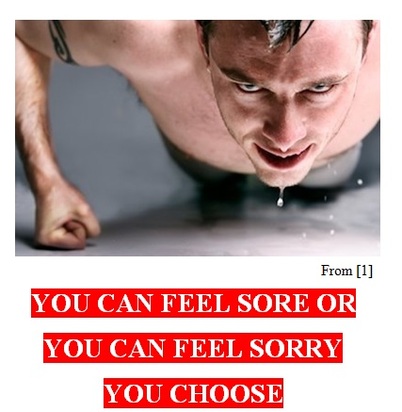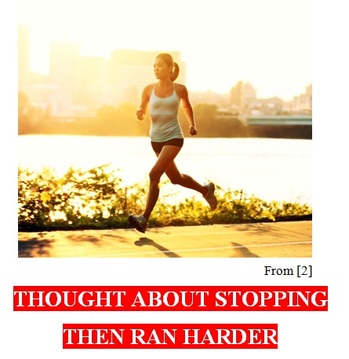 by Denise Croote '16 You can recognize a gym junkie by their duffel bag, oversized protein shake, and T-shirt deliberately modified to better expose their biceps. Whether they are body builders or marathon runners, we look at them, admire their commitment, and wonder how they find the motivation to train day after day. Do they ever want to curl up on the couch with a bag of buttery popcorn? Chances are they do. But what often sets these individuals apart is a compulsive need to exercise above all else—an addiction to strenuous physical activity. Of course, not all marathon runners and professional athletes are exercise addicts. There is a fine line between an exercise addict and an exercise enthusiast and whether or not one crosses it depends on their attitude towards exercising. Professional basketball players love their sport and even after years of training still consider it to be enjoyable. Exercise addicts on the other hand often despise going to the gym. Whether it is the act of exercising or the thoughts that go into planning their next workout, exercise is invariably on their minds. Many endurance runners fulfill several criteria outlined by the Diagnostic and Statistical Manual of Mental Disorders, Fifth Edition (DSM-5) for diagnosing an addiction. Runners can become dependent on the feelings of enjoyment, satisfaction, stress reduction, and accomplishment that follow physical activity (1). Not surprisingly, Type-A individuals working high-stress jobs are more likely to engage in compulsive physical activity. Chronic endurance runners also profess that they exercise, in part, to avoid the negative symptoms of withdrawal. These symptoms can develop 24 to 36 hours after the cessation of running, and typically include anxiety, irritability, guilt, and muscle tension (2). For them, a two-hour workout is ironically easier than eating a bag of buttery popcorn on the couch.  Despite warnings by doctors that further activity will result in knee, hip, ankle, or hamstring injuries, runners will continue to run. Very few exercise addicts can sustain their routines because their bodies cannot fully recover before the next workout and are constantly in repair mode. Compulsive exercisers can even develop a tolerance for exercising. One month, they feel satisfied after an hour. The next month, they up their training to two hours per day, and soon enough they are skipping dinner dates to go to the gym. Exercise that upsets the balance between social time with friends, holidays with family, and the ability to focus at work is a major red flag. Therefore, although regular physical activity has a wealth of beneficial effects, if taken to an extreme, it can be highly addictive and dangerous (3). So what exactly occurs in the brains of these gym junkies and causes their tremors to be quieted only by the sight of a treadmill? The answers lie deep within the brain, and researchers are just beginning to put the pieces together (4). In fact, chronic drug use and chronic exercise similarly shape rodents’ brains (1). Different pleasurable activities, including social interaction, food, music, and illicit drugs, activate the same brain circuit, the mesolimbic reward pathway. When, for example, we eat our favorite food or crowd surf at our favorite concert, neurons in the ventral tegmental area (VTA) release the neurotransmitter dopamine into the nucleus accumbens (NAc). This surge of dopamine is responsible for the sensation of pleasure and reinforces these behaviors (4). Exercise also activates this reward circuit. In one study, rats that followed an eight-week exercise regimen of wheel running had nearly twice the amount of dopamine in their brains than rats that didn’t (5). Another study found that six weeks of voluntary wheel running increased levels of tyrosine hydroxylase, the key enzyme for dopamine synthesis (6). Thus, exercise seems to not only release dopamine, but also enhances the brain’s ability to produce dopamine. Also of particular interest to researchers investigating addiction is the protein delta (∆)-FosB. Virtually all illicit drugs increase levels of ∆FosB, which accumulates in the NAc following chronic drug use and can produce changes in the brain long after quitting (7). This build-up partially explains why it’s so difficult to curb an addiction. Based on the above observations, researchers have long considered the possibility that ∆FosB mediates the addictive properties of exercise as well. Rats with access to a running wheel for 30 days ran 10 km/day on average and, at the end of the experiment, had significantly more ∆FosB than their sedentary counterparts (8). This raises the question: what does ∆FosB do in the NAc? A study examining the behavior of mice in response to cocaine treatment found that ∆FosB increases the levels of dopamine in the brain by inhibiting some of the proteins that decrease dopamine. Thus, ∆FosB increases dopamine, leading to additional feelings of reward (9). This flood of dopamine and the consequent feelings of pleasure help explain why gym junkies cannot resist the lure of dumbbells. So what can this tell us about a gym junkie? It appears that their desire to go to the gym may be less of a desire and more of a need. Their habits have hijacked their natural reward system and their symptoms are not all that different from drug addicts. Should exercise addiction be included in the DSM-5? Can we take what we know about exercise addicts to derive pharmacological treatments to help obese and overweight individuals exercise? If studies have shown that increasing ∆FosB motivates rats to run, could the same apply for humans (8)? The potential to increase one’s aptitude to remain physically active would benefit many individuals in the United States. For one, it would help obese individuals, which make up over one third of the population, maintain a healthier weight and avoid harmful weight-loss supplements (10). The mood-enhancing effects of exercise would also improve the mental state of depressed individuals, which make up about 9% of the population, while also providing relief from anxiety (11). The question is though, how can you find your balance? References:
Image References:
0 Comments
Leave a Reply. |
